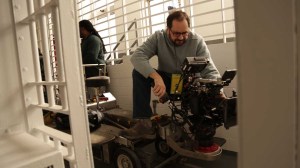
For Antonio Rossi, director of photography on the new CNN Originals documentary series Death Row Stories, a Canon kit containing the company’s EOS C500 4K Digital Cinema Camera, EOS 5D Mark III Digital SLR, and various Canon Cinema and EF-series lenses helped him delve deep into the compelling, untold stories behind capital murder cases with a set of cinematic options not available to dollar-conscious documentary filmmakers before. “The Super 35mm CMOS sensor, lovely color palettes, and dynamic range of the Canon EOS C500 wasn’t available to productions at our budget level in the past,” Rossi said. “Docs were typically shot using Super 16mm film or 2/3-inch ENG cameras, and the image difference with 35mm was extreme. Those formats provided completely different looks. But with these cameras, you can approximate some of the looks you’d get in feature films and higher-budget episodics to a much closer degree.”
Robert Redford and Laura Michalchyshyn executive produced the series for Sundance Productions along with Jigsaw Productions, Alex Gibney‘s documentary production company. Gibney directs the eight one-hour documentaries and actress Susan Sarandon, who won an Oscar for her role as Sister Helen Prejean in Dead Man Walking, narrates.
Using the C500 to shoot what he refers to as “quasi-reenactments,” mood roll and present-day interviews, and the 5D to shoot b-roll, Rossi captured the show in Rec 709 at 1080P. The team configured the C500 to record Avid DNxHD files to an external Sound Devices PIX 240i recorder. “Had this been a more of a cinéma vérité show I think Canon Log would have been a great way to go,” he said. “I prefer Canon Log for run-and-gun situations. But in controlled interview situations with little time for post the Rec 709 setting on the EOS C500 looked great. I wanted the people we interview to look great — to look natural — and the C500 handles skin tones really well.”
AbelCine provided the JR45Cine picture profile settings, loaded into the C500 via SD card. Rossi worked with Gibney to push those settings in the look direction the director envisioned for each scene, providing “a rich, gorgeous scene, very nice colors, and very flattering skin tones,” he explained. “Obviously, the subject matter of the show is pretty heavy and dramatic. There were times I wanted to increase the moodiness, and I was able to dial-in more contrast. The Canon EOS C500 let me do that easily by getting into the black gamma and I was able to use the JR45Cine picture profile as a jumping-off point for the looks I wanted.” The very first episode features stylized reenactments in Miami of events during the 1980s. “I took some inspiration from a Miami detective series and similar shows from that era, with bright colors and deep shadows,” Rossi said. “I also used a lot more gels than would be typical for a documentary to give it a more dramatic, filmic look. I really like the colors and the images that the EOS C500 camera can give me, and the directions I can push it in.”
Rossi prized the C500’s light, mobile body and minimal footprint Shooting Death Row Stories, but was most impressed with its versatility. “I love the fact that you can configure the C500 in a lot of different ways,” he said. “I generally like to build it up with long rods and a viewfinder to make it more like an ENG camera that’s steady on my shoulder. But if I’m running around with it, I can put a still prime on it, use just the top handle and the viewfinder, and keep a very low profile. Stripped down, it’s not really that much bigger than a still camera. And if we really need a low profile, we use the 5D. ”
The DP said the Super 35mm, 8.3 megapixel CMOS image sensor in the EOS C500 also let him take less than ideal locations and make something lovely and abstract out of them, letting him shoot much wider than he might with a smaller chip camera while still throwing the background out of focus. “It’s great to have the Super 35-size sensor that’s in the Canon EOS C500,” he said. “Shooting a documentary can often entail doing three or four interviews per day in different locations. This doesn’t allow you to have a pre-scout day for every location, a grip truck, or all the time you would really like for set-up. I did almost all the interviews with the C500 and my own Canon CN-E30-105mm Cinema Zoom lens, which is super-sharp and gives me the confidence to use it wide-open. I could also throw colors, light, and shadow in the background to create something beautiful without worrying about not having the best-looking location in the world.”
Canon’s CN-E24mm, CN-E50mm, and CN-E85mm Cinema primes were invaluable, Rossi said, to get even shallower depth of field in run-and-gun mode for mood roll. “You can shoot those lenses wide open and they’re beautiful, they’re sharp. And you can make the background super-abstract and mysterious. The bokeh was lovely.” His kit also included more affordable Canon EF still lenses: a CN-E30-105mm Compact Cinema Zoom for sit-down interviews, the EF 16-35mm f/2.8L II USM Ultra Wide-Angle Zoom, EF 24-70mm f/2.8L II USM Standard Zoom, and the EF 70-200mm f/2.8L IS II USM Telephoto Zoom for shooting re-enactments and very tight cutaways of interview subjects with the 5D Mark III. He used a 2x Extender, or doubler, with the EF 70-200mm f/2.8L IS II USM to get wildly inventive “super-abstract” exteriors.
In the end, said Rossi, the choice of kit came down to very specific creative choices that he, Gibney and the show producers discussed at length in pre-production. “I love the way the Canon cameras and lenses we used captured the light and the drama we were striving for.”





